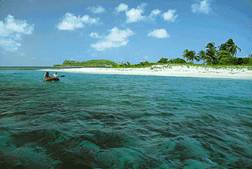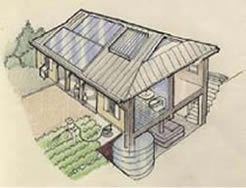Grenada
National Energy Policy * Solar Hot Water Systems * Nutmeg Biofuels * Earth Home * Other
 The nation of Grenada consists of three islands - Grenada with 120 square miles and about 90,000 inhabitants, Carriacou with 13 square miles and a population of about 5,000 and Petite Martinique with about 486 acres. Nicknamed the Isle of Spice, Grenada is a major producer of nutmeg, cinnamon, mace and cocoa.
The nation of Grenada consists of three islands - Grenada with 120 square miles and about 90,000 inhabitants, Carriacou with 13 square miles and a population of about 5,000 and Petite Martinique with about 486 acres. Nicknamed the Isle of Spice, Grenada is a major producer of nutmeg, cinnamon, mace and cocoa.
Although its proximity to oil and gas-rich Trinidad and Tobago makes it a likely source of as-yet-undiscovered gas and oil, Grenada also seeks to capitalize on its wealth of renewable resources. Grenada has decided to launch a comprehensive assessment of potential renewable resources including wind, biomass, geothermal, hydroelectric, and solar energy. Though Hurricane Ivan wreaked havoc on the island nation, causing an indefinite delay in many GSEII efforts, a new program focusing on sustainable reconstruction is ongoing.
Grenada Project Profiles
National Energy Policy / Sustainable Energy Plan Development
Objective: The development of the NEP and SEP for Grenada is particularly important and complex because of the massive destruction of Hurricane Ivan. This scenario presents an opportunity, however, for the development of sustainable policies and plans for the island nation.
Description: In 2006, the Sustainable Energy Plan was revised to integrate energy projects in national development and reconstructions plans with the Grenada Agency for Reconstruction and Development. GSEII and UNIDO, along with the OAS Caribbean Sustainable Energy Program (CSEP) have worked with the Grenadian government to finish the SEP started in 2002 and establish an NEP.
Update: In May 2009, members of OAS met with government officials to discuss developing a plan, initiating a process which will lead to drafting of a 20 year NEP with 3-5 year Sustainable Energy Plans.
Grenada Cooperatives League and Credit Unions Solar Hot Water Heating
Financing Program
Solar Hot Water Systems in the Caribbean Case Study
Objective: Grenadian electricity costs over 60 US cents per kWh. As Grenadians generally use electricity to heat their water, electricity bills can be significantly cut and energy can be saved by switching from electric hot water heating to solar hot water heating. Solar hot water heaters in the Caribbean, however, cost exorbitant amounts of money (upwards of $2500-$3000), which Grenadians largely cannot afford. As such, this project aims to help citizens purchase solar hot water heaters with the aid of a loan.
Description: The Organization of American States through their Sustainable Energy Program for the Americas (SEPA) have been in talks with local stakeholders and the Grenada Cooperatives League and Credit Union to work out the logistics for distribution of these loans and awareness campaigns.
Update: As of July 2009, an agreement was signed with the local credit union stating that a pilot $65,000 grant issued by the Trust for the Americas would be used for low-cost, long-term loans for citizens to buy the hot water systems. The project is expected to be launched in early 2010 with the credit union league set to launch a Consumer Awareness Campaign.
Earth Home Project
 Objective: Hurricane Ivan destroyed or severely damaged 90% of Grenada's infrastructure, including Grenadian homes. In response to this devastation, GSEII introduced the Earth Home concept to the island and is working to promote it throughout the nation in support of the sustainable development initiative.
Objective: Hurricane Ivan destroyed or severely damaged 90% of Grenada's infrastructure, including Grenadian homes. In response to this devastation, GSEII introduced the Earth Home concept to the island and is working to promote it throughout the nation in support of the sustainable development initiative.
Description: This project is in partnership with the Sustainable Design Group, Inc (SDG). The Earth Home system is fully integrated to support the lifestyle of those occupying it through sustainable means--electricity, hot water, cooking and a sewer system is built using local materials. Additionally, Earth Homes are made from compressed earth brick, have solar ovens, rain water collection capabilities, sustainable construction methods, waste water management, and compost.
Update: In fall 2006, John Spears of SDG outlined the earth home at a workshop in Grenada. Since then, plans have been made to build a model earth home for future developers. GSEII is facilitating the creation of this model home.
Grenada Nutmeg Shell to Energy Project
 Objective: Before Hurricane Ivan struck Grenada, the nation produced an average of 5,200 tons of wet nutmeg every year, processing it for export to the international spice markets. Nutmeg shell is a biomass residue that potentially can be used as a carrier to deliver energy to different types of end energy users in the country. This project concentrated on electricity production from the residue.
Objective: Before Hurricane Ivan struck Grenada, the nation produced an average of 5,200 tons of wet nutmeg every year, processing it for export to the international spice markets. Nutmeg shell is a biomass residue that potentially can be used as a carrier to deliver energy to different types of end energy users in the country. This project concentrated on electricity production from the residue.
Description: The project looked at a 50 KW capacity plant using nutmeg shells and steam cycle technology for the generation of electricity, and perhaps process heat as a combined heat and power (CHP) plant to be used in conjunction with an upgrade to the existing nutmeg refinery already installed in northern Grenada.
Update: Due to Hurricane Ivan in August 2004, the nutmeg trees were severely damaged, and it is estimated that it will take about 8 to 10 years for nutmeg production to return to normal. The project has therefore been postponed indefinitely.
Other Past & Present Projects
- Development of a photovoltaic energy system for the Grenada Chocolate Company: In January 2005 a study conducted by GSEII found this project was found not economically viable.
- Energy Systems Analysis: In spring 2006, GSEII and the World Bank introduced a project to focus on electricity energy system.
- Energy Efficient Lighting: GSEII worked with Grenadians to replace conventional light bulbs with energy efficient CFL bulbs.
- Aiding discussions with the utility for the development of a 225 KW wind turbine on Carriacou Island.
- Development of a GRENLEC Utility Micro Hydro plant was identified as a possible project in 2003.
- Possibility of auditing energy efficiency in the hotel sector was identified in 2003.
- Providing technical support for the implementation of the Grenada government's Electricity Supply Act.
